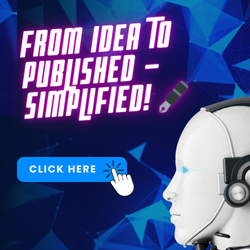
How to Choose the Right AI Writing Assistant
- Creative Process
Choosing the right AI writing assistant can feel overwhelming with so many options available. The key is to find a tool that aligns with your specific writing needs and goals. Do you need help with grammar and style, content optimization, generating ideas, or crafting long-form content?
Understanding Your Writing Needs
Before diving into the world of AI writing tools, it’s crucial to clarify your specific requirements.
- What type of content do you create most often?
- Content marketing and SEO: blog posts, website copy, social media content
- Business Writing: emails, reports, presentations
- Academic Writing: research papers, essays
- Creative Writing: fiction, poetry, scripts
- What features are most important to you?
- Grammar and Style Enhancement: Error correction, clarity, tone adjustments
- Content Optimization and SEO: Keyword analysis, readability, engagement suggestions
- Idea Generation and Brainstorming: Overcoming writer’s block, exploring new concepts
- Long-form Content Generation: Drafting articles, ebooks, or other long-form pieces
- Specialized Writing Tools: Formatting citations, generating creative prompts, industry-specific templates
- How much content do you produce, and how often?
- Occasional use vs. daily writing
- High-volume content creation needs
Types of AI Writing Assistants
The market is flooded with a variety of AI writing tools, each with its strengths and specializations. Here’s a breakdown of the main categories:
- GPT-Powered Comprehensive Platforms
- Capabilities: These platforms offer a wide range of features, from brainstorming and drafting to editing and adapting to specific contexts. They can handle diverse writing tasks.
- Examples: ChatGPT, Claude
- Grammar and Style Enhancement Tools
- Focus: These tools excel at improving writing quality through advanced linguistic analysis. They go beyond basic spell-checking to offer suggestions for clarity, tone, and style improvements.
- Examples: Grammarly, ProWritingAid
- Content Optimization Specialists
- Goal: These AI assistants help writers create content that is effective for SEO (search engine optimization) and audience engagement. They analyze successful content to provide data-driven recommendations.
- Examples: Clearscope, Surfer
- Specialized Writing Assistants
- Academic tools: These tools help researchers with drafting papers, formatting citations, and maintaining scientific writing standards.
- Creative writing platforms: Assist with story development, character creation, and plot structuring.
- Business-focused assistants: Specialize in professional communications, from email writing to report generation.
- Autonomous AI Agents
- AutoGPT represents a new category of AI writing tools that can manage complex writing tasks with minimal human input. They use chains of AI agents to plan, research, write, and refine content independently.
Key Evaluation Criteria for AI Writing Assistants
When comparing different AI writing assistants, keep these criteria in mind:
- Accuracy and Reliability:
- Fact-checking: While AI can be helpful, it’s essential to verify the information it generates, as AI systems can sometimes produce inaccurate or fabricated content (known as “hallucinations”).
- Contextual understanding: Assess how well the AI understands the nuances of your writing and avoids misinterpretations.
- Flexibility of Writing Style and Tone:
- Can the AI adapt to different audiences, purposes, and writing styles?
- Is it capable of maintaining a consistent tone throughout your content?
- Customization Options:
- Personalization: Look for tools that allow you to adjust settings to match your writing preferences and style guide.
- Templates: Some platforms offer templates for specific content types (e.g., emails, blog posts).
- Pricing and Value:
- Free trials: Take advantage of free trials to experiment with different tools before committing.
- Subscription models: Understand the different subscription tiers and the features they offer.
- Usage limits: Consider tools with flexible usage limits or pay-as-you-go options if your needs are unpredictable.
- Value for money: Determine if premium features justify the cost based on your specific requirements.
- Integration Capabilities:
- Platform compatibility: Does the tool integrate with your preferred writing platforms (Microsoft Word, Google Docs)?
- Browser extensions: Extensions can enhance usability and streamline your workflow.
- Mobile apps: Access your AI assistant on the go for writing and editing convenience.
- API access: If you’re a developer, API access might be essential for customizing the tool or integrating it with other systems.
- User Experience (UX) and Interface:
- Intuitiveness: Choose a platform with a user-friendly interface and easy navigation, even for those new to AI writing tools.
- Learning curve: Consider the time and effort required to learn the tool’s features and get comfortable using it.
- Customer Support and Training Resources:
- Help documentation: Look for comprehensive help articles and tutorials.
- Support channels: Access to responsive customer support via email, chat, or phone can be invaluable if you encounter issues.
- Training materials: Webinars, video tutorials, or other training resources can help you maximize the tool’s capabilities.
Ethical Considerations and Best Practices
While AI writing assistants offer many benefits, it’s crucial to use them ethically and responsibly.
- Originality and Plagiarism Avoidance:
- Human review and editing: AI-generated content should always be carefully reviewed and edited by a human writer. Treat AI as a collaborator, not a replacement for your own skills and judgment.
- Plagiarism detection: Utilize plagiarism detection tools to ensure the originality of your content.
- Maintaining Your Voice and Style:
- Personalize AI output: Edit and refine the AI’s suggestions to match your tone, style, and brand guidelines.
- Don’t over-rely on AI: Use it to enhance your writing, but ensure your unique perspective and voice remain central.
- Data Privacy and Security:
- Read privacy policies: Understand how the AI platform handles your data and content.
- Choose reputable providers: Opt for tools from established companies with strong data security measures.
- Transparency in AI Use:
- Disclose AI assistance: Consider being transparent with your audience about when and how you use AI writing tools.
Future Trends in AI Writing
The AI writing landscape is constantly evolving. Keep an eye on these trends:
- Multimodal AI Systems: Future AI writing tools will seamlessly combine text, image, and voice capabilities for a more comprehensive and intuitive content creation experience.
- Increased Personalization and Specialization: AI assistants will become more adept at adapting to individual writing styles and preferences, offering increasingly tailored support.
- Seamless Integration with Business Ecosystems: Expect tighter integration with content management systems, marketing platforms, and other productivity tools.


